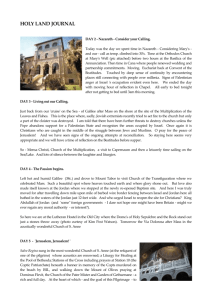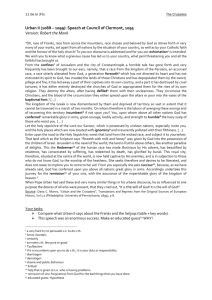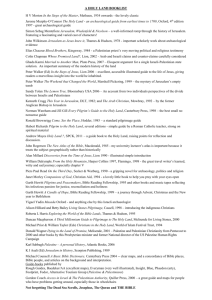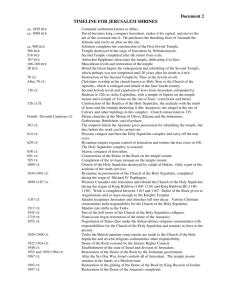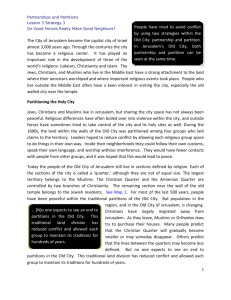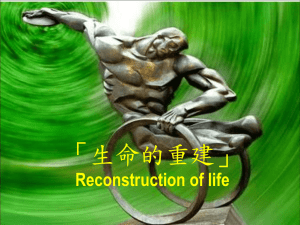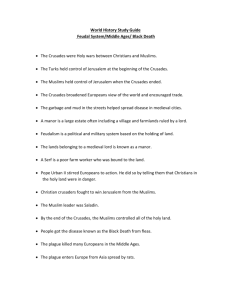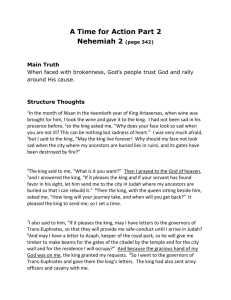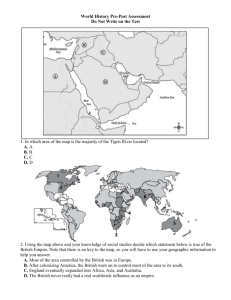The Sepulchre of Christ and the Medieval West
advertisement
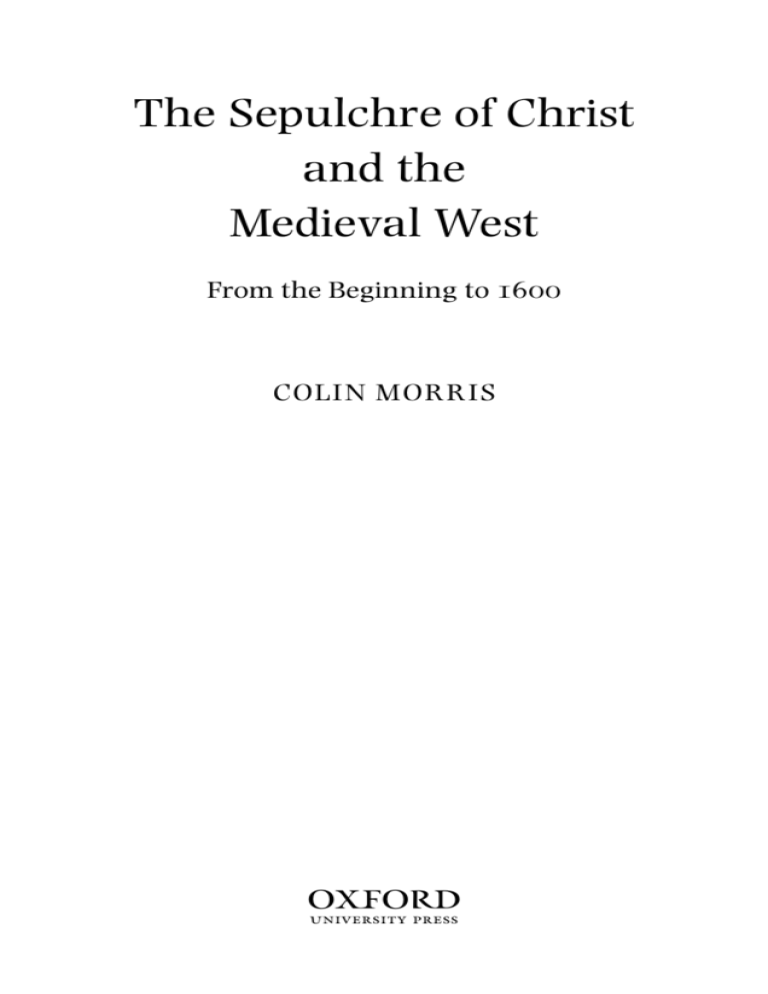
The Sepulchre of Christ and the Medieval West From the Beginning to COLIN MORRIS 1 Contents List of Figures Abbreviations Introduction . Beginnings, to The Ministry and Death of Christ From Jerusalem to Aelia Was there a Cult of the Tomb of Jesus in the First Centuries? Jerusalem Lost . Consequences of Constantine, – Discoveries: The Holy Sepulchre Discoveries: The Wood of the Cross Discoveries: Calvary Authenticity The Buildings Visitors to the Holy Sepulchre . Dissemination: The Spread of Interest in Western Europe, – Pilgrimage to the Holy Sepulchre under the Christian Empire Holy Places in Christian Thinking Bringing the Holy Sepulchre to the West The Holy Sepulchre and Christian Symbolism The Wood of the Cross Comes to the West The Influence of Liturgy . The Frankish Kingdoms and the Carolingians, – Jerusalem under Muslim Supremacy Expectation Pilgrimage to the Holy Sepulchre, – Jerusalem and the Carolingian Liturgy Buildings Commemorations of the Holy Sepulchre Relics of the Cross and Passion x xii xviii viii . Contents Towards the First Crusade The Consequences of Caliph al-Hakim ‘An innumerable multitude’ Relics, the Wood of the Cross, and Personal Devotion New Versions of the Sepulchre War against Saracens The First Crusade . Latin Jerusalem, – Introduction The Liberation of the Holy Sepulchre ‘A new day’ Rebuilding Zion Pilgrims The Development of Crusading Ideas ‘Mixing knighthood with religion’ . Christendom Refashioned The Sense of Christendom Memorials in the West: Relics Commemorations of the Holy Sepulchre The Internal Pilgrimage The Threat to the Holy Sepulchre . Failure and Endeavour, – Jerusalem Lost The Thirteenth-Century Reassessment The Passion and Sepulchre in the Holy Nation . The ‘Great Pilgrimage’ in the Later Middle Ages, – The Way of War and the Way of Peace The ‘Great Pilgrimage’, – The Literature of Pilgrimage Centre and Circumference . . Sepulchres and Calvaries, – ‘A long way from Jerusalem’ Sacred Societies ‘The exact design and measurement of the Holy Sepulchre’ Stations of the Cross and Holy Mountains The End of the Pilgrimage, – ‘The pilgrimage in danger’ Contents The Pattern of Decline The Survival of Pilgrimage Literature Spiritual Pilgrimage Kingly Powers and the End of the Crusades Bibliography Index ix Introduction T original starting-point of my interest in this subject was the proclamation of the First Crusade at the Council of Clermont in . While historians have disagreed about the intentions of Pope Urban II, it has been generally accepted that Westerners were deeply concerned with the fate of Jerusalem. To see its recovery for Christian rule as Urban’s primary purpose is the simplest interpretation of the evidence, but other writers have concluded that the taking of Jerusalem was a distortion introduced by the imperative demands of Western opinion, which distorted a project originally designed for the protection of Constantinople. Such explanations take it as an axiom that Latin Christians were deeply concerned about the fate of the city in Palestine, but this concern itself requires explanation. There were good historical reasons why the faithful might have regarded the fate of the city with indifference. Palestine was a very little country and a long way away––a very long way indeed for medieval land travellers. In the long run it proved impossible to sustain a successful military effort in such a distant place. More profoundly, Christianity was a universal religion with at first a limited attachment to holy places, and the Jerusalem of the Old Testament had been completely destroyed and replaced by a Roman city. Christian propaganda saw this as a condemnation of its role in the crucifixion of the Saviour. It has been said by a recent scholar writing from a Protestant viewpoint that in the history of the church as a whole, interest in Jerusalem ‘was the exception rather than the rule’. The Western concern for the Holy Sepulchre and its effect on European history and society alike require examination. Historians of the church have not often investigated this subject: it is remarkable how little the tomb of Christ is mentioned in general histories. That is partly because it has largely disappeared from our contemporary culture. In spite of the importance of the historical Jerusalem in modern archaeology, tourism, and politics, there is not much awareness of it in Christian devotion. Westerners barely remember that there is a (diminishing) Christian community in Palestine. The hymn books contain plenty on the heavenly Jerusalem, on pilgrimage, and on spiritual warfare, but I have searched them in Introduction xix vain for material on the city in Palestine similar to that which fed the medieval imagination. The same is true in scholarly circles: commentaries on the Gospels rarely use the topography of Jerusalem to elucidate the events of the passion. Saint Paul may have proudly claimed that ‘this thing was not done in a corner’ (Acts : ), but to judge by the way some people have written, one would think that it had happened on the moon. Enthusiasts of pilgrimage literature may notice that I have made little use of concepts that are now common currency, such as the idea of ‘sacred space’ and the vocabulary that is sometimes associated with it (‘liminality’). This is because they express our contemporary concerns rather than those of the past. They belong to a world which is interested in comparative religion and in ideas of holiness which are found in different cultures. They also reflect the prevailing modern scepticism about shrines. Modern Western people do not on the whole believe in the power of relics or the benefit to be derived from indulgences, and as a result our thinking about the subject is often concentrated on the nature of the pilgrimage journey itself and the self-awareness it induces. Undoubtedly past writers were interested in what it was like to travel, and we shall find many examples of that. But their primary concern was with the place or shrine to which they were travelling. There is nothing wrong with exploring wider boundaries of thought, but this book has a more limited goal: to understand the ideas of past generations, and the way they shaped the society of the time. That still leaves us with more than enough to do. By its nature the Holy Sepulchre cannot be isolated from the rest of Christian culture. A few yards away, the place of the crucifixion was identified on the hill of Calvary and the relics of the cross were allegedly found. It is not possible to discuss the significance of the Sepulchre without including the cult of the cross and the veneration of its relics. In consequence, in order to avoid writing a total history of Christendom, I have exercised self-denial, although the reluctant reader might not suppose so. There is more to say about the extent to which the Holy Sepulchre was the target of the various crusades than is said here; and I have been selective in the choice of memorials of the Sepulchre, many of which present teasing problems of intention and dating. Palestinian and Egyptian monasticism were shaped by the proximity of the holy places, and their influence on religious life in the West was great, but this is a subject not pursued in this book. Nor have I considered in detail the impact on cartography of the idea that xx Introduction the Sepulchre was the compas or centre of the earth, nor yet the crucial position of the Jerusalem events in the development of drama in the late Middle Ages. There are problems, too, about writing in a post-Christian age. One is the recurrent question of authenticity: although I have briefly considered the credentials of the Holy Sepulchre itself, I have not challenged the reality of the numerous relics that will scatter the coming pages. From the point of view of the historian what matters is that contemporaries believed in most of them: critics and cynics existed, but they were not enough to prevent the emergence of numerous shrines and pilgrimage centres. It is difficult, too, to make allowance for writing in a multicultural society. With some exceptions the attitude of medieval Christendom to Muslims and Jews was intensely hostile. I have made some attempt to explain the importance of the Holy City, al-Quds, to the Muslims who were fighting to defend and recover it, but the total question of religious intolerance and misjudgement is far too large to approach here. Another major limitation of a different kind has been the decision to stop this history in the sixteenth century. There was a break at this time in the desire to visit and defend the Sepulchre. The holy places at Jerusalem, after an interval, were once again to become a major political and cultural influence on world history; but the circumstances are different, and one has to stop somewhere. The shape of the discussion will inevitably follow the progress of scholarship. Archaeological work in the church of the Holy Sepulchre has now given us a much better idea of its history, culminating in Martin Biddle’s essential work on the structure of the Sepulchre itself. There has been new thinking about the emergence of the reverence for holy places in the fourth-century church. The last generation has also seen an immense amount of work on the crusades, and on the development of the veneration of the cross and the form of the crucifix. Pilgrimage in general has been abundantly studied. The changing ways in which the Sepulchre was represented in Western art, on the other hand, have been given less attention, in spite of some normative articles, and so has the diminishing importance of the resurrection of Christ in the accepted pattern of devotion. Whatever the precise significance attached to them, memorials of the cross and Sepulchre can be found all over Europe. The traditional culture of the English church was disrupted at the Reformation, but in many medieval buildings one can trace signs of what was originally the Easter Sepulchre, and in almost all churches on Easter Sunday an Easter garden, with the hill of Golgotha, Introduction xxi the three crosses and the empty tomb are depicted in a pleasing model. The Golgotha events, the passion, entombment, and resurrection, left a mark on the buildings and social arrangements on communities far from Jerusalem. The small town of Rue in Picardy still preserves in its layout the recollection of its earlier importance. It was once a significant port, but its harbour disappeared with the silting of the coast. Memories of Jerusalem have marked this moderate-sized town at the opposite end of Europe. The connection was established at an early date when the parish priest, Wulphy, went on pilgrimage to the Sepulchre of Christ. On his return, he lived as a hermit until his death about , and the parish church is now dedicated to his memory. That was not all. In , shortly after the crusaders’ conquest of Jerusalem, a ruined boat was discovered in the harbour, containing a statue of Christ (or was it a complete crucifix? the accounts are uncertain). The find was later improved by the legend that the image had been placed in a boat without sail or rudder in Palestine, and had found its own way to Picardy. The story dictated the ecclesiastical architecture of the town. In the middle years of the fifteenth century a magnificent chapel of the Holy Spirit was built in flamboyant style on the north side of the parish church through the generosity of King Louis XI of France. It was designed to admit the streams of pilgrims to adore the miraculous crucifix, whose story was depicted on its doors. The parish church collapsed in and was rebuilt on a smaller scale, leaving a gap between the church and its former side-chapel, but the church still has a nineteenth-century Gothic reliquary containing fragments of the statue of Christ. There is also a large wooden cross beside the old harbour, commemorating the place where the boat was found, and marked on the town map as ‘Croix de Jérusalem’. The Sepulchre and the cross shaped the history of this small port in Picardy. We do not know for certain where the tomb of Christ was. We can be sure only that it was at Jerusalem, outside the wall which surrounded the city at the time when Pontius Pilate was governor. When, immediately after , excavations were undertaken at the command of the Emperor Constantine, a cave that they revealed in the outskirts of Jerusalem was at once identified as the tomb of Jesus of Nazareth. For more than years, this identification has been accepted by most Christians, and in this volume (although we shall take note of questions about authenticity) this tomb will simply be called the Holy Sepulchre. xxii Introduction The enormous influence of this place is to be explained by the Christian desire to remember the saving acts of God in Christ. Jacques Le Goff has even said that ‘Christianity is memory’. Memory, memoria, could have a much more material form than it has for us: objectively the Sepulchre at Jerusalem, or a relic from it, or a picture or copy of it, was a ‘memory’ that people could visit on pilgrimage or carry with them on their persons. For Muslims to have possession of the Sepulchre of Christ was in itself a defilement in Christian eyes, which carried with it the danger that the church would lose its ‘memory’. These attitudes do not form a necessary part of Christian belief: they were seriously different in the Greek churches, and perhaps at no time were they universally held. They were, however, dominant in the medieval West, which was to play such a large part in the future shaping of the world. The purpose of this book is to examine how this attitude to the Holy Sepulchre arose, and what its cultural and historical consequences have been. Beginnings, to The Gospels leave us with a disputed picture of the presence in Jerusalem of Jesus of Nazareth. Mark, Matthew, and Luke do not define the length of his public preaching ministry: the three years traditionally assigned to it rest on a precarious deduction from the text of John. The natural meaning of the text of the first three Gospels is that the ceremonial entry by Jesus into the city a few days before the crucifixion was his first public appearance there. Luke in particular presented the decision to go to Jerusalem as a major turning-point in the life of Jesus: ‘when the days drew near for him to be received up, he set his face to go to Jerusalem’ (Luke : ). In John’s Gospel, several earlier visits are mentioned, and a more careful examination of the other Gospels tends to confirm the presence of Jesus in Jerusalem on a number of occasions. The repeated disputes with scribes, lawyers, and Pharisees can be located more naturally there than in Jesus’ homeland of Galilee, and the anxiety of the authorities about his preaching is easier to understand if he already had a following that welcomed him when he made his solemn entry. The writers of the Gospels were not inclined to make much of the Jerusalem ministry of Jesus, but stress the importance of the period of a few days during which he entered the city, engaged in controversy in the Temple, was arrested, tried, executed, and buried. They saw the tomb as the memorial of a short visit and brutal reaction by the authorities. The earliest description which we have of the tomb of Jesus is that by St Mark, written probably about , some forty years after the events that it describes: The evidence is succinctly set out by J. M. O’Connor, ‘Pre-Constantinian Christian Jerusalem’, A. O’Mahony (ed.), The Christian Heritage in the Holy Land (London, ), –. Beginnings, to And when evening had come, since it was the day of the preparation, that is the day before the sabbath, Joseph of Arimathea, a respected member of the council . . . took courage and went to Pilate, and asked for the body of Jesus . . . And when he learned from the centurion that he was dead, he granted the body to Joseph. And he bought a linen shroud . . . and laid him in a tomb which had been hewn out of the rock; and he rolled a stone against the door of the tomb. Mary Magdalene and Mary the mother of Joses saw where he was laid. And when the sabbath was past, Mary Magdalene, and Mary the mother of James, and Salome, bought spices, so that they might go and anoint him. And very early on the first day of the week they went to the tomb when the sun had risen. And they were saying to one another, ‘Who will roll away the stone for us from the door of the tomb?’ And looking up, they saw that the stone was rolled back–– it was very large. And entering the tomb, they saw a young man sitting on the right side, dressed in a white robe; and they were amazed. And he said to them, ‘do not be amazed; you seek Jesus of Nazareth, who was crucified. He has risen, he is not here; see the place where they laid him.’ (Mark : –: ) Mark was writing in Greek for a church that had many contacts with the Gentile world, but his description fits closely into the tombculture of Judaea. As Martin Biddle has emphasized, ‘the kind of tomb suggested by the Gospel accounts is consistent with what is now known of contemporary practice in the Jerusalem area’. It appears that the tomb used for the body of Jesus was a new one (Matthew : ; Luke : ; John : ), and we can safely imagine a cave entrance, protected by a rough stone. The interior would have some sort of antechamber, and the tomb proper have a burial bench (or benches?). Such a layout would fit Mark’s report that the women were invited to look into the tomb to see the empty burial-place. His is not an imaginary reconstruction created in a foreign context. Nor is there any reason to suppose that the penalty of crucifixion would exclude a solemn burial afterwards: we know of the ossuary of a certain Yehohanan, whose remains show clear signs of death by crucifixion some time in the first century. Nobody tells us where the tomb was. It must have been outside the city wall. Burial inside a classical or Jewish city was inconceivable: Cicero had recalled the legal prohibition, ‘do not bury or cremate a dead man in a city’. If the first Christian writers did not usually say that it was outside the wall, that was because no other possibility would have occurred to them. There is a confirmatory hint in the J. Zias and E. Sekeles, ‘The Crucified Man from Giv’at ha-Mivtar: A Reappraisal’, Israel Exploration Journal, (), –. Beginnings, to Palestinian Tomb Culture Very large numbers of tombs survive at Jerusalem and in the highlands of Judaea. They are difficult to date, but they give us a clear picture of the prevailing customs of burial. Ordinary people received simple burials. At Beit Safafa, outside Jerusalem, bodies were placed at the bottom of shafts, and elsewhere they were laid in an excavation in the bedrock, a foot or so beneath the surface. Richer families would have more elaborate rock-cut graves. Inside there would be enough space to admit a small burial party, and benches were provided on which a body could be placed. Further chambers might be cut into the rock to provide for family burials. There is just such a complex, now rather perversely ascribed to Joseph of Arimathea, at the western end of the church of the Holy Sepulchre. The entrance to a tomb would be provided with a large stone, which could give protection but also allow access. Flattened stones (rather like later millstones) which would run easily along a rock-formed channel did exist, but only in elaborate tombs. Usually the bench area was simply cut out of the wall, and the chamber had a flat ceiling extending over it, but a substantial minority had a bench cut beneath an arch or arcosolium. Subsequently the body, which had been prepared and left on the bench, would be disarticulated. Shortly before the birth of Jesus, it became customary to place the bones in a bone-box or ossuary. The custom was widespread in Jewish society, especially in the area of Jerusalem, and prevailed until the fall of the Temple in , and in some cases a good deal longer. E. Bloch-Smith, Judahite Burial Practices and Beliefs about the Dead (Sheffield, ); Biddle, Tomb, –; E. Regev, ‘The Individualistic Meaning of Jewish Ossuaries’, PEQ (), –. statements that Jesus ‘went out . . . to the place called the place of a skull’ (John :), and that Simon of Cyrene was recruited to carry the cross ‘as they went out’ (Matthew : ). It seems to have become an established tradition in the church that ‘Jesus suffered outside the gate’ (Hebrews : ). The only additional evidence comes from the statement by John, and John only, that the tomb was Beginnings, to close to the place of crucifixion: ‘in the place where he was crucified there was a garden, and in the garden a new tomb where no one had ever been laid . . . The tomb was close at hand’ (John : –). The evangelists do give us the name of the place of the crucifixion. All of them agree that it was called Golgotha, the Hebrew or Aramaic word for skull, and all provide the Greek translation kranion (‘cranium’) (Mark : ; Matthew : ; John : ; and Luke : –– although Luke, mindful of the sensitivities of his Greek readers, spares them the barbarous Hebrew word). It is not surprising that such a sinister place-name caught the attention of these writers, but its use implies that they expected readers to know where it was. Unfortunately, no other contemporary source mentions Golgotha. As it stands in the text it sounds as if it were the name of a small district, but no early evidence enables us to identify it. Speculation about the origins of the name are, I think, pointless. In relatively recent periods efforts have been made to search for a place which would have once looked like a skull. Apart from the impossibility of reconstructing in detail the scenery two thousand years ago, there is no reason to suppose that this was the derivation of the name. During the century after the death of Jesus, the city near which his body had been buried was utterly transformed. The first change was the extension of the walled area of the city on its north-eastern side. We do not know the precise position of the city wall at the time of Christ, but we do know that Herod Agrippa, between and , built a new one further out. Unfortunately, the description Josephus gives us of the position of the walls of Jerusalem cannot easily be made to tally with its topography or the results of archaeological investigation. Herod Agrippa’s extension of the city area has a special importance from our point of view. It is probable that the wall of Jesus’ time (what Josephus described as the ‘second wall’) excluded from the city the important site where subsequently Constantine was to build the church of the Holy Sepulchre. This had certainly been included in the city area by . We shall be revisiting this site, and assessing the information it offers, in a later chapter. Given the aversion to the presence of bodies of the dead among the living, The evidence is briefly summarized in Biddle, Tomb, –, and J. Wilkinson, The Jerusalem Jesus Knew (London, ), –. Beginnings, to the extension presumably involved emptying the tombs in the enlarged area. The next disturbance was on a cataclysmic scale. Tension had been mounting for some years between the Roman authorities and Jewish nationalists, and a complete split between them in led to a long civil war. In the legions of Titus broke into Jerusalem, and in the course of the assault the Temple caught fire and was wholly destroyed. That was far from being the end of the transformation of the city. Some years later the Emperor Hadrian, a liberal Hellenist who had no sympathy for the obscurantist practices of narrow religions, decided on a total rebuilding. It is not clear whether this radical plan was the reason for another major Jewish revolt, or the response to it. Whichever is the correct explanation, the Bar Kokhba rebellion had been suppressed by and the great rebuilding could be put into action. The city became a Hellenistic polis, and received the name Aelia or Aelia Capitolina, after the emperor’s own name, Publius Aelius Hadrianus. Jerusalem no longer existed. The attempt to obliterate the name was probably deliberate, and is paralleled by the renaming of the province of Judaea as Syria-Palaestina. It was successful for a long time. In the fourth century, the church historian Eusebius called the modern city Aelia, and it seems that the very name Jerusalem was forgotten in government circles. The Byzantines dropped the ‘Capitolina’, perhaps because of its implications of pagan worship, but the name Aelia was still sufficiently established in the seventh century for the city to be called ‘Iliya’ in Arabic. Unfortunately, there is no surviving account from Hadrian’s time describing the works he undertook. The written evidence comes from the fourth century, when Christian writers, notably Eusebius and Jerome, reflected on what had happened. Apart from the classical layout of the main streets, Hadrian apparently created pagan shrines on two major sites: the old Temple ruins and a quarry on the western edge of the city, where the tomb of Christ was later identified. They must both have been attractive propositions for building development. The Temple platform in all probability still offered a solid foundation for major building, and the quarry site was close to the new main street or cardo. Eusebius’ assumption that Hadrian intended to Michael Grant, The Jews in the Roman World (London, ), ff.; D. Golan, ‘Hadrian’s Decision to Supplant “Jerusalem” by “Aelia Capitolina”’ , Historia, (), –. Eusebius, Martyrs of Palestine . (PG . –), and Y. Tsafrir, ‘Byzantine Jerusalem: The Configuration of a Christian City’, in Levine, –. Beginnings, to desecrate a known Christian site was natural, but rested on no solid information: Certain ungodly and impious persons had determined to hide this cave of salvation from the eyes of men . . . Having expended much labour in bringing in earth from outside, they covered up the whole place. Then, when they had raised this to a moderate height and paved it with stone, they entirely concealed the divine cave within a great mound. Next . . . they prepared above ground a . . . building to the impure demon called Aphrodite. Whatever Hadrian’s intentions, archaeological investigation confirms that there was indeed a major Roman construction on the site, but unfortunately it cannot be conclusively shown that (as Eusebius apparently indicates) it stood on a landfill and raised podium. Nor is there agreement among the later descriptions of the site about the location of the various places of pagan worship. It may well be that there was a temple of Venus/Aphrodite on the site of the quarry, and another temple to Jupiter (or more strictly to the Capitoline triad of Jupiter, Minerva, and Juno) within the limits of the Temple Mount, where a statue of Hadrian himself was also erected. In any event, from for two centuries the area that the church of the Holy Sepulchre was later to occupy had become inaccessible, buried beneath buildings designed by Hadrian’s town planners for pagan cults. Hadrian’s buildings may have had the paradoxical effect of marking it strongly upon the memory of the local community: if they could no longer visit it, the temple made sure that it would not be forgotten. The physical transformation of Jerusalem between and had been so enormous that it refashioned not only the appearance of the city, but its very identity, and consequently the thinking of the communities that reverenced it. The Jews were now excluded from their former holy places. Even in the fourth century, they were allowed access for only one day of the year, to lament the fall of their Temple on its anniversary. This obviously had a profound impact on the character of Judaism, but the effect upon Christians was scarcely Eusebius, Life of Constantine . (PPTS . ). On this conflict of evidence, see S. Gibson and J. E. Taylor, Beneath the Church of the Holy Sepulchre Jerusalem (London, ), ch. . Virgilio Corbo attempted an ambitious reconstruction of the details of the Hadrianic temple on the quarry site, Il santo sepolcro di Gerusalemme, vols. (Jerusalem, –); but see R. Ousterhout in Journal of the Society of Architectural Historians, (), –, and D. Bahat, ‘Does the Holy Sepulchre Church Mark the Burial of Jesus?’, Biblical Archaeology Review, (), esp. . Beginnings, to less. The church at Jerusalem was, in the time of the apostles, a largely Jewish body, and it is clear from the Acts of the Apostles that it was influential in the affairs of the international church. The cataclysmic events of the first and second centuries left a powerful mark on the Jewish Christian community. It may be that shortly before the destruction of many of them left the city and moved to the distant town of Pella, although the historicity of this move is uncertain; nor is it clear whether they returned. After , with the end of the Second Jewish War, the remaining Christians in Aelia were a largely or wholly Gentile community. The Judaeo-Christian tradition was weakened by these events, and much of the early Christian literature in Hebrew or Aramaic disappeared; the new Scriptures accepted as authoritative have been entirely in Greek, and addressed largely to Gentile readership. It may well be that the widespread preaching in Mediterranean cities would in any case have created this shift towards a predominantly Greek religion, but the events of and accelerated it in a dramatic fashion. The continuous, observable, history of the Holy Sepulchre begins just after . Until that time, the experiences of the Christian community at Jerusalem/Aelia had been traumatic, and were divided by the chasm in . A largely Jewish church had become a Gentile one, and if there had been any Christian sacred sites where Hadrian chose to build, they were no longer available for Christian reverence. This raises the important question whether the church in the centuries before Constantine knew or cared where the tomb of Jesus was. There are reasons to suppose that they did so. There was in Judaism a strong popular interest in the tombs of the patriarchs, prophets, and martyrs. It was an ancient tradition: Nehemiah could see Jerusalem as ‘the city of my ancestors’ graves’ (Nehemiah : ). Holy men and women were believed to work wonders from their tombs and to intercede effectively with God, and in the generation before Christ a series of splendid memorials had been built to the illustrious departed. Some of the contemporary structures, such as the tombs attributed to Absalom and Zacharias in the Kidron valley, can still be seen near M. Simon, ‘La Migration à Pella, légende ou réalité?’, in Judéo-Christianisme: recherches historiques et théologiques offertes en homage au cardinal Jean Daniélou (Paris, ), –, and O’Connor, ‘Pre-Constantinian Christian Jerusalem’. Beginnings, to Jerusalem. Even apart from such commemorations of the great and good, concern for burial in the family grave was widespread. It is hard to think that the burial place of Jesus would be regarded with indifference by his followers, especially when the head of the church at Jerusalem was his own brother, James. For that matter, the location of the tomb of James himself, who was executed in , was still known when Hegesippus wrote over a century later. The strength of the argument for commemoration is increased by the fact that the tomb of Jesus, as it is described in the Gospels, was in some sense an honorific one. It was certainly not on the same level as the more elaborate memorials in the Kidron valley, but nor was it an anonymous shaft or surface burial. Memory, in various senses of the word, will be a central theme of this book, and in the early centuries it was fundamental as providing a framework for thinking and locations: ‘diligent memorialisation of important sayings and locations was a sacred task, as well as a social duty’. This would be a knockdown argument in favour of continued veneration, were it not for the unique character of the tomb of Jesus. All other graves were venerated because of the presence of the holy remains; but that of Jesus was important precisely because his body was believed not to be there. There seems to be no way of deciding whether, in these very special circumstances, the normal arguments for expecting a veneration of the tomb retain their force. There is, however, another line of argument that may strengthen the case for thinking that there was early reverence for the Sepulchre. As devout Jews, the early Christians kept the passover (or, to use the contemporary name, Pascha) as the centre of their annual calendar, and since their Lord had died then for their salvation, the events of the crucifixion and resurrection were remembered as part of the deliverance of Israel. The reality of this observance can be seen in the treatise On Pascha written by Melito of Sardis in the s. The importance of Pascha may provide a basis for a more speculative suggestion, that the passion narrative in the Gospels incorporates reminiscences of liturgical observances from the earliest days, and a record of the places where events took place, including those which happened at the tomb. During the two centuries between Hadrian and Constantine, from to , the material is thin, but there are a few pieces of evidence Thiede, –. S. G. Hall (ed. and tr.), Melito of Sardis, On Pascha (Oxford, ). Beginnings, to The Passion Story and the Tomb The passion story is distinctive within the Gospel narrative. While most of the records of Christ’s life were preserved in brief snippets, the record of the crucifixion and resurrection displays an unusual continuity, within which time and place are carefully preserved. The narrative does not distinguish sharply (as modern devotion tends to do) between the death of Jesus and the visit to the tomb, but reflects the spirit of the early paschal festival by keeping both within one continuous whole. Its function was to provide a standardized record of these crucial events, at a time when the first apostles were no longer alive to act as witnesses; but how it was constructed is one of the mysteries of early Christian literature. There are indications that in the process of composition use was made of reminiscences from worship. It begins and ends with striking ritual actions, the anointing of Christ at Bethany and in the tomb (Mark : – and : ), and the account of the Paschal meal has a crucial place within it. There are acclamations that suggest quotations from worship: ‘Hosanna! Blessed is he who comes in the name of the Lord!’ (Mark : ). It is full of teaching, both by Jesus and the evangelists, which is addressed to the whole Christian community and is not simply required by the flow of the narrative: ‘wherever the Gospel is preached in the whole world, what she has done will be told in memory of her’ (Mark : ). There are also some verses that would gain enormously in power if they were designed to be read or acclaimed in the place to which they refer. The words ‘he is not here; see the place where they laid him’ (Mark : ) almost demand to be said at the Sepulchre. For all the attractions of this theory, it has its problems. While some elements of the passion story sound like prescriptions for worship, others do not, and advocates have had to suppose that there was an earlier form, which was rewritten for inclusion in the Gospels, but which has left no other trace. Even some who believe in the existence of an original passion liturgy are not convinced that it was connected with the Holy Sepulchre as it subsequently emerged. Trocmé, while affirming the early community’s awareness of the topography, holds that ‘there is no continuity whatever between Beginnings, to the concrete localizations of the years – and the arbitrary designations attempted years later’. One basic certainty does remain amid the doubts: the location of the events is an essential part of the record. Mark had given us very few references to places throughout most of his Gospel, but in the last few days he introduced us to Bethphage and Bethany, the Mount of Olives, the Temple and its treasury, the upper room, the courtyard of the high priest, and finally Golgotha and the tomb of Joseph of Arimathea. This makes sense only on the assumption that the hearers knew where these places were, however uncertain we may be about the devotions by which they were honoured. G. Schille, ‘Das Leiden des Herrn: die evangelische Passionstradition und ihr Sitz im Leben’, Zs. für Theologie und Kirche, (), –, and E. Trocmé, The Passion as Liturgy: A Study in the Origin of the Passion Narrative in the Four Gospels (London, ). that tend to suggest that the location of the Holy Sepulchre was still known to the church. Just after , Melito of Sardis wrote in his treatise On Pascha that Christ had been put to death ‘in the middle of Jerusalem . . . in the middle of the square and the middle of the city and the middle of the day, for all to see’. Shortly after the great theologian Origen, who had resided in Palestine for some time, reported a tradition that Adam was buried at Golgotha, a statement that strongly suggests that the church in Palestine knew where it was. What is more, Eusebius, in his treatise on the place-names of Palestine, the Onomasticon, mentioned that Golgotha ‘is shown’ at Aelia, north of Sion. While this leaves open the question of what he meant by ‘north of Sion’, he plainly had a specific location in mind. We shall also have to notice later the important evidence of a letter from the Emperor Constantine to Bishop Macarius of Aelia. In this, he spoke of his desire to free from ‘the heavy weight of idol worship a spot which has been accounted holy from the beginning in God’s judgement’. Clearly, people regarded it as a holy place. There is also a teasing modern discovery Origen, Commentary on Matthew : – (PG . ). Eusebius, Onomasticon , –. The book was written before the work of Constantine at Jerusalem, perhaps as early as the s. Beginnings, to Melito in the Middle of the Square The evidence of Melito is important, because it is the first reference to the location of the crucifixion and the first record of a Christian visitor to the Holy Land (outside the New Testament, that is), and because it appears to contradict the tradition that Jesus suffered outside the city wall. Melito went to Palestine, but we do not know that he actually visited Aelia or that he had made his visit by the time he wrote On the Pasch. Perhaps he was merely using theological symbolism based on a text such as ‘working salvation in the midst of the earth’ (Psalm : ) or ‘the street of the great city . . . where their Lord was crucified’ (Revelation : ). It may be the earliest instance of the Christian appropriation of the Jewish belief that the Temple was the centre of the world. But his words do sound like a piece of town mapping, and it may be that Christians from Aelia pointed out to him the site on the main street, with its new imperial temple, where they had once visited the tomb of the Lord. If so, it is the first reference to the place where later the Holy Sepulchre was identified. But, obviously, we cannot be sure. A. E. Harvey, ‘Melito and Jerusalem’, Journal of Theological Studies, (), –; S. G. Hall (ed. and tr.), Melito of Sardis, On the Pasch (Oxford, ), , , and ; and Biddle, Tomb, –. of an impressive votive panel of a ship, difficult to date and unexpectedly found under the Constantinian basilica. It is clear evidence of pilgrimage, but it was an odd site for a pilgrim to be visiting, and unfortunately appears to have been damaged during its discovery and restoration. It has generated a large amount of discussion, but it seems most probably to be a pagan offering that antedated the work of Constantine, and may conceivably be a stone reused from some other site. The likelihood that there was some continuing knowledge of the site of the Holy Sepulchre is supported by the Gibson and Taylor, Beneath the Holy Sepulchre chs. –, conclude that ‘we believe with some degree of confidence that the ship drawing was made during the second century A.D., and that it is not the work of a Christian pilgrim of the early fourth century’. See also J. Wilkinson, ‘The Inscription on the Jerusalem Ship Drawing’, PEQ (), –. Beginnings, to undoubted fact that the site of the birth at Bethlehem was known: Justin Martyr implied its existence in about , and in Origen unambiguously wrote that ‘in Bethlehem you are shown the cave where he was born’. The evidence for Christians visiting the Holy Land in the period before Constantine is limited, but the weight of probability seems to me to be in favour of a real interest in the sites there. Whether the travellers of the centuries before Constantine should be regarded as pilgrims in the later sense is not entirely clear. They are rather differently described. Melito’s purpose in coming to Palestine was said to be ‘to know the accurate facts about the ancient writings, how many they are and in what order’, while Clement of Alexandria, Origen, and Alexander, who later became bishop of Aelia, are said to have come for reasons connected with ecclesiastical politics or teaching. As major figures they were more likely than others to have some obligation to public service to cause them to travel. They also said that they had come ‘to see the traces of Jesus, of his disciples and of the prophets’, as Origen remarked in his commentary on John : . Learned curiosity or historia for a long time was a major theme in tourism. Jerome observed later that a Christian scholar would be interested to visit Palestine in the same way that classical students would want to see Athens, and Melito and Origen do not seem to be far from that position. ‘Pilgrims’ in the later sense is our word, and not theirs, and the decision whether to describe them as such is therefore in the end almost a matter of taste. A small number of statements have sometimes been taken as demonstrating that the location of the tomb was not known in the third century, but they do not carry the weight of doubt that has been placed upon them. When Eusebius said that the discovery of the cave ‘transcends all marvel’, he need not have meant that they had no idea that this was the site of the Holy Sepulchre; only that contemporaries did not imagine that it could have survived the massive works of Hadrian. Several writers commented that ‘the For references, and further evidence, see G. S. P. Freeman-Grenville, The Basilica of the Nativity in Bethlehem (Jerusalem, ), –; and P. W. L. Walker, The Weekend that Changed the World: The Mystery of Jerusalem’s Empty Tomb (London, ), , , and . S. Hall (ed. and tr.), Melito of Sardis, , fragment , taken from Eusebius, Ecclesiastical History . –; and Jerome, ep. . . Eusebius, Life of Constantine . (PPTS, . ). Beginnings, to place was hard to find, the persecutors of old having placed a statue of Venus on it, so that, if any Christian should presume to worship Christ in that place, he would seem to worship Venus. Thus, the place had fallen into oblivion.’ This suggests that there was still a tradition of where Golgotha was, however difficult it was of access. The balance of probability is that the site of Golgotha, like certain other Biblical sites, remained known to the Palestinian Christians during the first three centuries. It is another question, to which we must return, whether the place of Constantine’s excavations was the same as the Golgotha of Origen and the Onomasticon. Christians had quite quickly lost the holy places which they had originally reverenced: first the Temple, and subsequently (on the assumption that it indeed been a place of reverence) the tomb. One early reaction to the destruction of the historical Jerusalem was the belief that it would be replaced by a new and perfected city. The author of the Apocalypse saw ‘the new Jerusalem’: it was ‘coming down out of heaven from God, having the glory of God, its radiance like a most rare jewel’ (Revelation : and –). This passage spoke clearly of the descent of Jerusalem to earth, even if later ages understood it as the heaven to which they hoped to ascend. The obvious meaning of the text is that the city ruined by the Roman armies would be replaced by a new one, the eschatological Jerusalem where the saints will dwell in triumph. Justin Martyr, in the middle of the second century, professed complete confidence that Jerusalem would be rebuilt. There was, however, another strand in the thought of the early church. The worship of God, no longer bound to the historical Jerusalem, was perceived as being henceforth universal, to be found wherever the faithful are assembled. Even before the destruction of the Temple by Titus, St Paul had dismissed Jerusalem from its preeminent place: ‘the present Jerusalem’, he wrote, ‘is in slavery with her children; but the Jerusalem above is free, and she is our mother’ This observation seems to come from the Ecclesiastical History of Gelasius (Borgehammar, ), and is likely to preserve a genuine local recollection from the middle of the fourth century. Justin, Dialogues (The Ante-Nicene Fathers, (Buffalo, ), ). Beginnings, to (Galatians : –). This sense of freedom from geographical limits marked Christian thinking in the first few centuries. God is to be worshipped wherever his faithful servants are. The point was already clearly expressed in the words in which Jesus criticized at once the Jewish and the Samaritan idea of the necessity of worship at a holy place: ‘the hour is coming, and now is, when the true worshippers will worship the Father in spirit and truth, for such the Father seeks to worship him. God is spirit, and those who worship him must worship in spirit and truth’ (John : –). There is a good deal in the early Fathers in line with this thinking: ‘The Jerusalem below was precious, but is worthless now because of the Jerusalem above . . . For it is not in one place, nor in a little plot that the glory of God is established, but on all the ends of the inhabited earth his bounty overflows.’ The Fathers were happy enough to perceive Jerusalem as a symbol: Tertullian saw it as representing faith as against Athens, and Cyprian recollected the authoritative model that it provided for Christian living in Acts : . Josef Engemann stated the implications of this early Christian universalism: ‘Pilgrimage originally was not a Christian devotional practice. Visiting a particular place, which was connected with the earthly life of Christ, or with the life and death of martyrs and saints, essentially contradicts the intentions of Christianity.’ In the first decades of the fourth century, Eusebius of Caesarea was to be the principal chronicler of Constantine’s work at the Holy Sepulchre. Nevertheless, in most of his voluminous work, Eusebius dismissed the claim of Jerusalem to be the city of God. His study of Palestinian place-names, the Onomasticon, normally refers to the city by its pagan name of Aelia, and uses ‘Jerusalem’ only in a historical sense. Eusebius could be scathing about any attempt to claim spiritual status for Jerusalem. Commenting on the text, ‘Glorious things are spoken of you, O city of God’ (Psalm : ), he wrote acidly: E. P. Sanders, ‘Jerusalem and its Temple in Early Christian Thought and Practice’, in Levine, –. Paula Fredriksen sees the Gospels as the point at which the rejection of the Temple was incorporated into Christian thinking: ‘The Holy City in Christian Thought’, N. Rosovsky (ed.), The City of the Great King (Cambridge, Mass., ), –. Hall, Melito of Sardis, . See L. Perrone, ‘ “The Mystery of Judaea” (Jerome, ep. ): The Holy City of Jerusalem in Early Christian Thought’, in Levine, –. J. Engemann, ‘Das Jerusalem der Pilger: Kreuzauffindung und Wallfahrt’, Akten XII. Beginnings, to To think that the formerly established metropolis of the Jews in Palestine is the city of God is not only base, but even impious, the mark of exceedingly base and petty thinking . . . Its gates are now deserted and destroyed . . . The city of God is clearly . . . the godly polity throughout the world. It is the church of God which is the greatest city fit for God. In the second and third centuries, therefore, the earthly city of Jerusalem and its Temple no longer existed. The church proclaimed a God who was worshipped wherever believers lifted up their hearts to him or the community broke bread in his presence, a presence which was not located in certain sanctuaries. Such reflections do not necessarily exclude the existence of holy places; nor do they mean that the location of the Holy Sepulchre was unknown or of no interest. In the first centuries, however, there was, as far as we can trace it, no sense that such holy places had replaced the Temple in God’s plan of salvation. They might be seen as evidences of Biblical truth, but the heart of the matter was that the sacred city and places had been swept away, and a new religion of open accessibility had arisen instead. Thinking of that sort provides an unpromising beginning to a study of Christianity’s greatest holy place. It is incompatible with any idea that the Holy Sepulchre is central in the purposes of God. For a full discussion, see P. W. L. Walker, Holy City, Holy Places? (Oxford, ), with the reference on p. .
